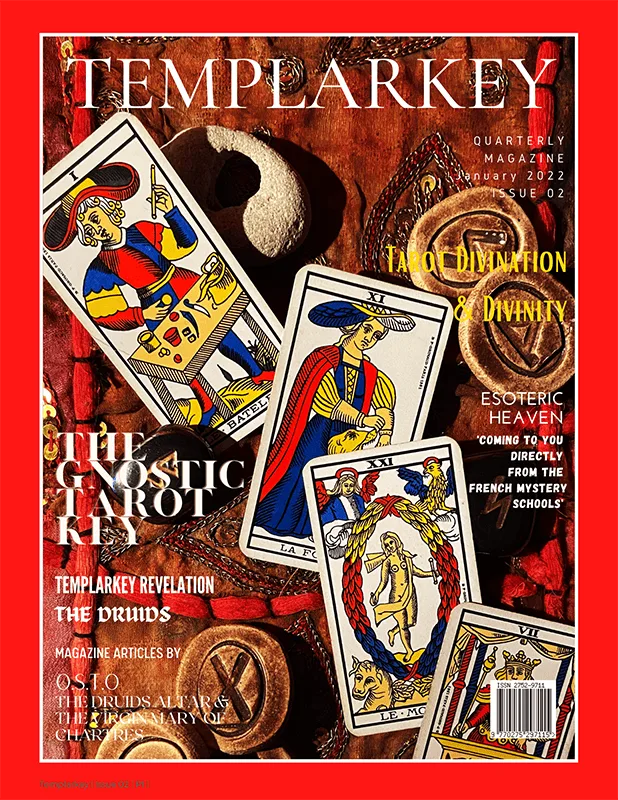The Traditional Tarot (modern Tarot) is a deck of cards (Tarot pack) rich with symbolic imagery, esotericism & mysticism.
The classic Tarot card deck, used in readings, has 78 cards, including the four traditional suits, an additional suite of trump cards, and a Fool card. The Major Arcana, which includes the trump suit and the Fool card, is a 22-card deck currently utilised for divination and allegorical depiction.
The four suits are the forerunners of the modern cards similar to the ‘spades’, ‘hearts’, ‘diamonds’ and ‘clubs’ in a regular deck of playing cards. Unlike England, Tarot is still played in France as a classic card game and is sold in nearly all supermarkets.
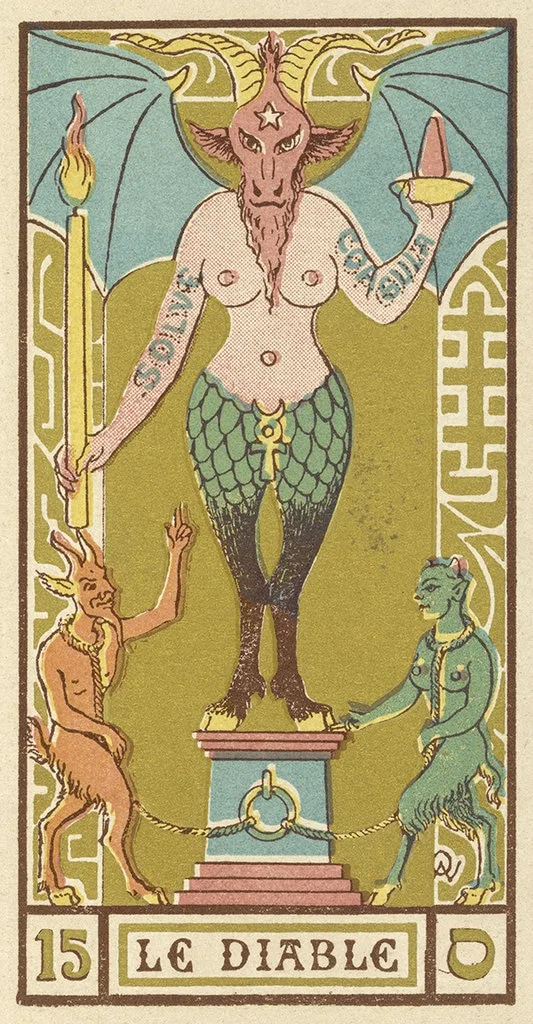
Where did the Tarot Decks originate, when, and a comprehensive explanation?
- What is the difference between Tarot and Oracle?
- The History of Tarot
- Where do Tarot cards originate from
- What was the first Tarot deck?
- Egyptian Tarot history
- What religion do tarot cards come from
- Tarot cards major arcana
- What are the 78 Tarot Cards
This Templarkey article will explain some of the complicated histories of the Tarot, its Etymology and Gaming decks. For Italian-suited decks and Italian-Portuguese-suited decks, The World of Playing Cards website offers its readers a comprehensive history of playing cards.
What culture does the Tarot originate from? Is Tarot somehow related to ancient Hebrew traditions, and what are the various meanings of different Tarot cards? We ask and answer these questions and more in our Issue 2 [January 2022] Templarkey Magazine: Are the Emerald Tablets of Thoth real, and how is it linked to the Tarot? What’s the best quality tarot deck (original)? And why is Tarot essential for you?
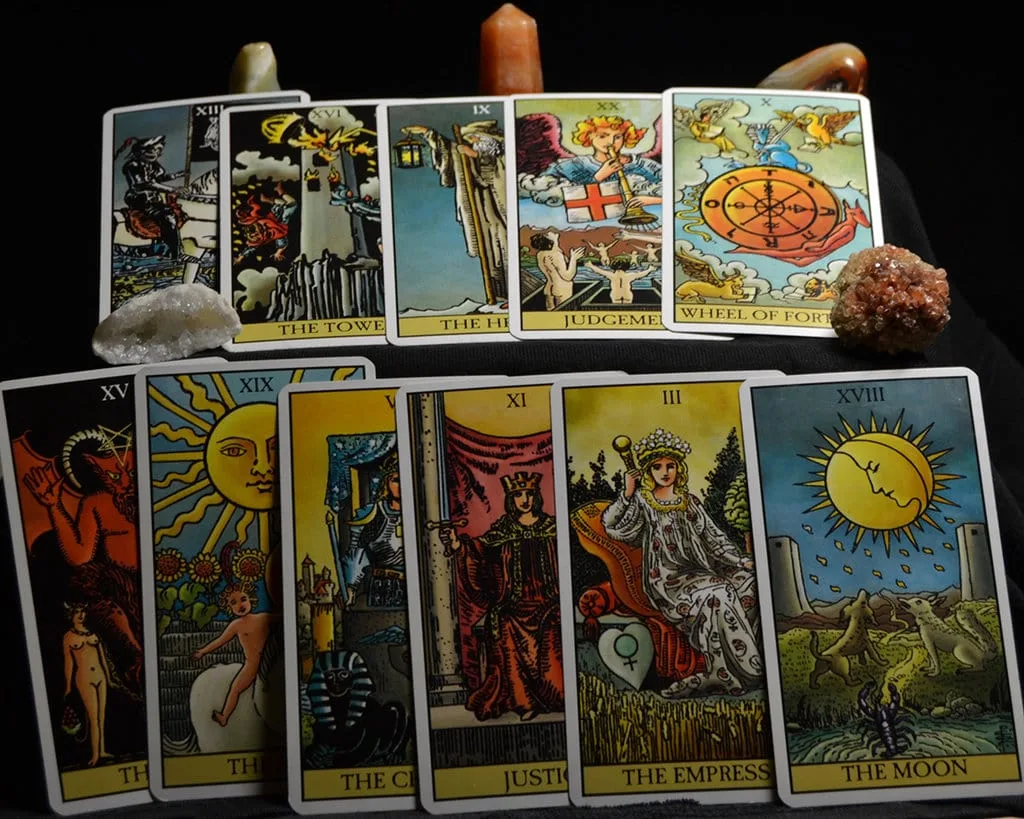
Tell me the difference between the Major Arcana Tarot Cards and the Minor Arcana.
Tarot, Astronomy or magic works for many Tarot readers in accordance with “As above, so below; as below, so above.”—The Kybalion, the great Second Hermetic Principle. Each card represents a person, place or event. Major Arcana cards symbolise significant ground-breaking influences. There are minor arcana that talk about lesser secrets that reflect everyday situations.
The suit symbols of Italian playing cards were Swords, Cups, Batons, and Coins by the middle of the 15th century, and they remain that way to this day—the value of the pip cards as indicated by the repetition of the symbol on each card.
However, in tarot cards, the 21 trump cards, or tarocchi, were added and depicted as in The Courtly Household Cards, with the fool at the bottom leading up to the Emperor and Pope at the top.
Tarot was first mentioned in the northern Italian cities of Venice, Milan, Florence, and Urbino during the 1440s and 1450s. Because of the game’s complexity, it is likely it had already undergone significant change towards the end of that century. With values ranging from 10 to 1 and four face cards (king, queen, knight and knave), tarot cards were constructed using the conventional Italian suit system.
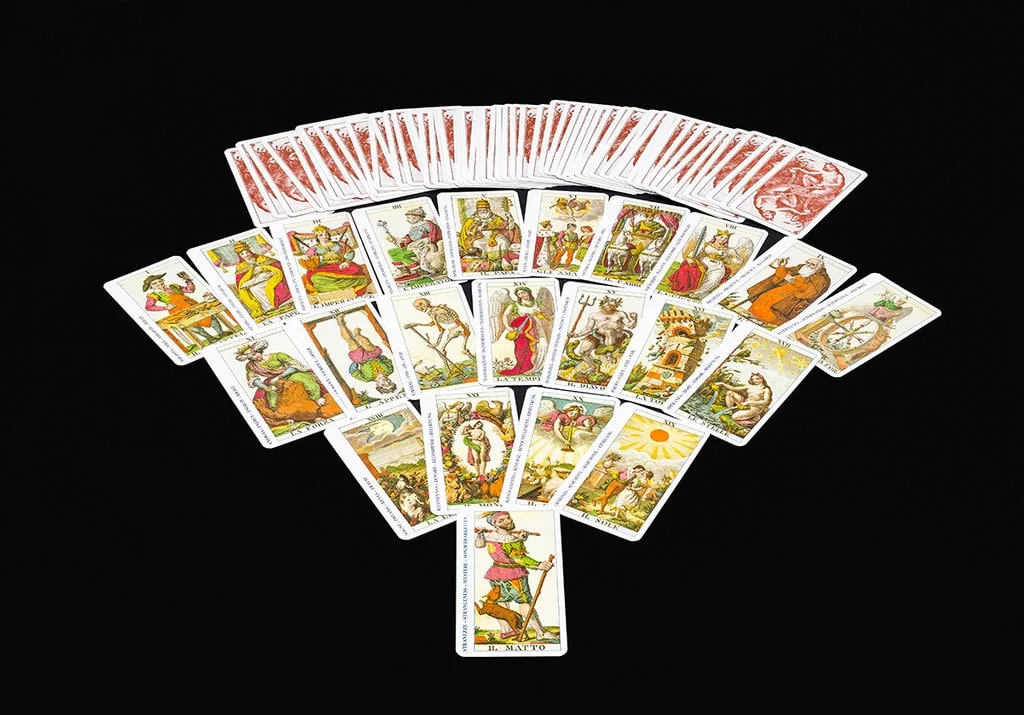
How many Cards are there in a Deck of Tarot Cards? (78)
The Minor Arcana cards in most decks of Tarot are divided into four suits, each containing ten numbered cards and four court cards. Each suite can correspond to specific astrological elements and their original era of life. According to some Tarot readers, these suits reveal which spheres of influence are being activated, giving insight into how best to take care of the situations.
The ace represents the beginning of events, while 10 represents the ending. The progression of the court cards shows our comprehension of circumstances on an individual level, expressing either personality styles or actual people. Pages Knights, Queen and King interpret circumstances with ever more understanding.
How do I start Reading Tarot Cards?
Many of our members at Templarkey ask us how to read Tarot Cards; therefore, we offer you this simple article. For the adept or the more serious Tarot researcher, Issue 2 [January 2022] of the Templarkey magazine offers you extremely informative information from our School of Tarot. We even provide our members with a free Tarot card reading. On the Templarkey website, our member’s area has free online readings of Tarot cards, and through our direct messaging service and magazines, we recommend books and offer links to where to buy tarot cards.
The Major and Minor Arcana cards in the Tarot (standard deck) create an exemplary pictorial language. All the answers we search for are innate to each card in the deck and indicate a person/situation, if any, the potential outcome. For the clearing of the cards to ensure the most accurate of readings, we recommend cleansing your deck every time you do a reading. It is a critically necessary first step in Tarot readings of the Cards as it opens the path between spiritual aspects and the cards.
Because there are no secrets or secret agendas with Tarot, the ability to discern meaning lies within your narrative interpretation of Tarot reading in the card decks. It is important to remember that all the answers are in the cards of your own deck. Can you read in-depth for a stranger? Can you focus on the deeper cause in their situation and help you make specific questions for them? The Templarkey School of Tarot can answer these questions and more in its members’ area with tarot cards online.
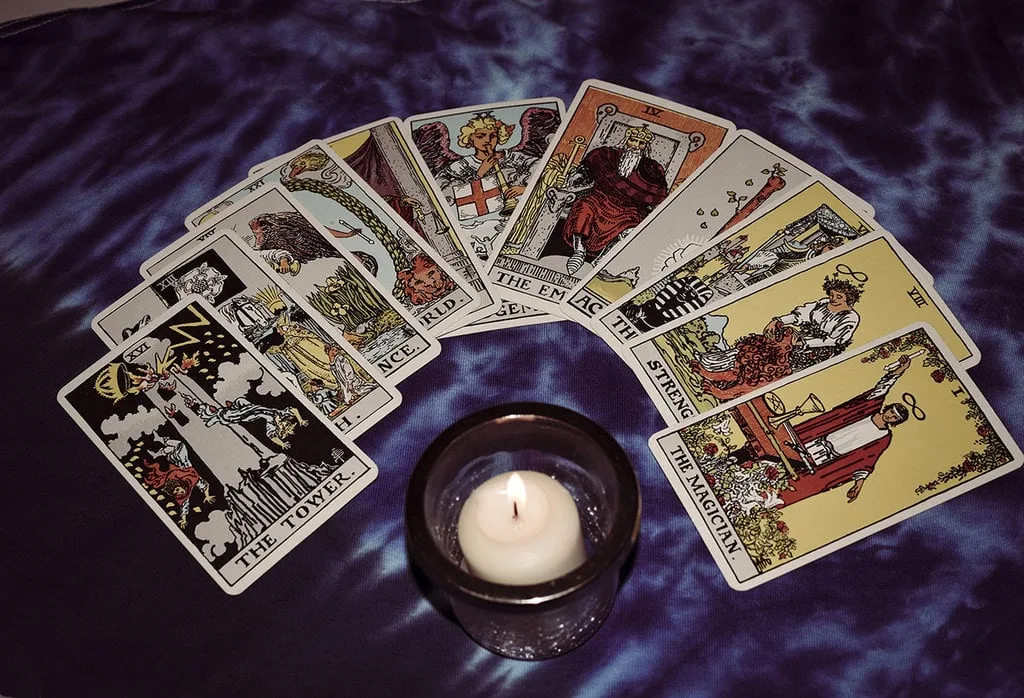
The Three Card Spread
What are tarot spreads with three cards?
Simply put, three-card tarot spreads are readings in which three cards from any common deck are drawn. They are generally read from left to right, and each card conveys a unique meaning, yet they all have some correlation.
Three-card tarot spreads are used by many as a method to progress from single-card readings to a more in-depth exploration of the Tarot for the more mystical readers.
These three card spreads are, in our opinion, not ideal as, within France, four cards are used as three cards do not cover the four aspects we need for actual reading. Four cards are an ideal starting point for providing a more detailed readout without becoming too convoluted or difficult to interpret. As a result, they are one of the most accessible Tarot spreads for novices.
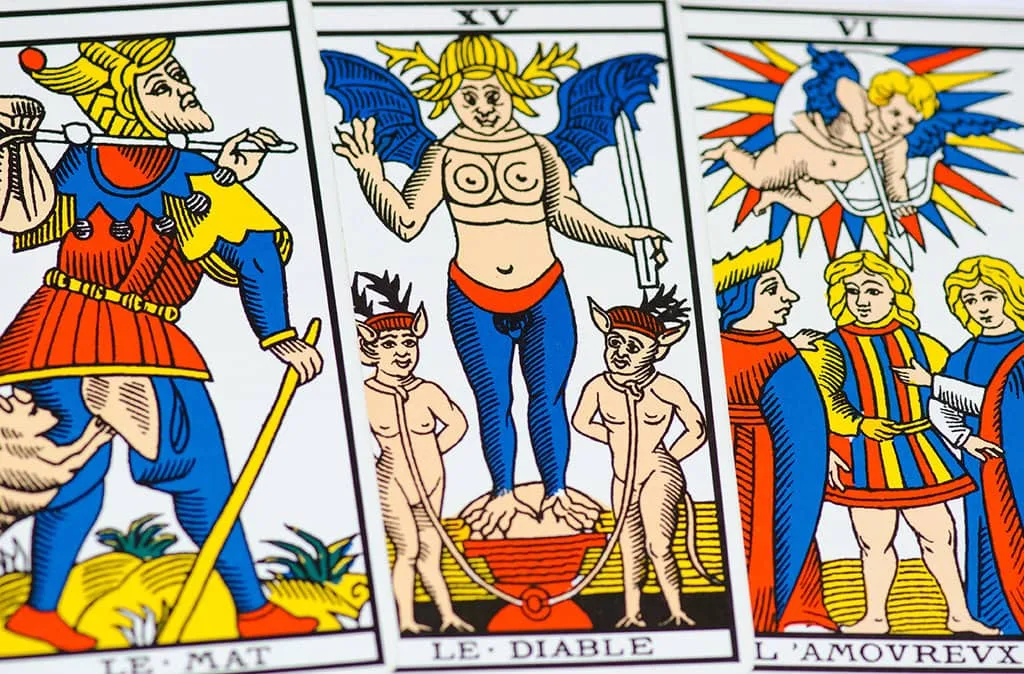
Playing Cards or Tarot Deck, French & Italian Tarot (the history of Tarot)
The history of Tarot (the etymology of the word Tarot) is derived from the Italian word tarocchi, whose root taroch means “foolishness.” Templarkey will offer an alternative explanation for the origins of this word (Tarot) within Issue 2 [January 2022] of its magazine.
The term taroch was first used in the 15th century when trionfi (a 70-card game inspired by the Italian Renaissance Triunfo theatrical processions) became popular.
Trionfi cards were often gilded and illustrated with anthropomorphic and allegorical images. The trionfi game became known in Italy as tarocho and in France as taraux, a phrase that later evolved into Tarot.
When trionfi cards first appeared in Italy, they were purely for entertainment purposes. Each deck included four suits (Swords, Batons, Coins, and Cups) as well as trumps, which were the highest-ranking cards. The trump motifs vary in each deck, with classical themes being prevalent.
The oldest recorded appearance of the game’s rules is in an early 15th-century manuscript. This document, written by Martiano da Tortona, a chancellor and secretary to Milanese Duke Filippo Maria Visconti, details a deck of 60 cards, 44 of which feature representations of birds (the eagle, turtle dove, dove, and phoenix). And 16 of which feature portraits of Roman gods (Jupiter, Apollo, Mercury, Hercules, Juno, Neptune, Mars, Aeolus, Pallas, Diana, Vesta, Daphne, Venus, Bacchus, Ceres, and Cupid).
As Tortona remarked, “each of the gods, however, is superior to the orders of birds and the ranks of monarchs,” it is self-evident that these 16 cards are trumps.
For the oldest Tarot, see The Visconti-Sforza Tarot, from the workshop of Bonifacio Bembo (Italian, Cremonese, active ca. 1442–died before 1482); visit the excellent Metropolitan Museum’s dedicated website. The Visconti-Sforza is now divided: 26 of the surviving cards at the Accademia Carrara, Bergamo and 35 at the Morgan Library & Museum, New York.
We have seen the history of the Tarot and the origins of what we now know today as ‘Tarot Cards’ date back as far as the early 14th century. Artists in Europe created the first playing cards for games and featured four different suit designs. After a decade of using these in the mid-1200s, Italian artists began to paint additional card illustrations, which added to the existing suits.
The nobility would require artists to design their own set of cards using family members and friends as triumph cards. Only through printing presses the basic card decks for the typical games were being manufactured in mass quantities for use in the general public.
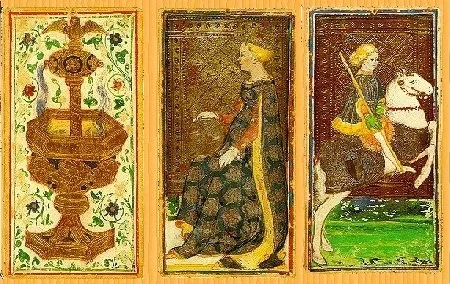
Tarot as Divination
Tarot was designed as a parlour game in France and Italy, not as a divinatory tool. It appears that divination with playing cards began being popular in the late 16th and early 17th centuries.
It was then much more straightforward than our current Tarot. People began to assign specific powers of meaning to cards and suggested ways to put them for divinatory purposes. Eventually, things began to come to life in the 18th century and to the modern sense of the history of Tarot.
Where does Tarot come from?
Surprisingly, the use of using Tarot cards as a divination tool is relatively modern. Although Tarot decks, as we know them now, date back to the 1400s, these pictorial cards were initially used by people for memory lessons (Arte Memoria Philosophica), pedagogy, and games rather than for predicting the future. Cartomancy, or so-called fortune-telling through the use of playing cards, was not developed until 1785, when the French occultist Jean-Baptiste Alliette, known by his pseudonym, Etteilla. This name was created by the inversion of his surname; he created comprehensive links between illustrated cards, astrology, and ancient Egyptian lore.
Jean-Baptiste Alliette (1 March 1738 – 12 December 1791) was the first person known in history to popularise tarot divination to a broad audience (1785). Thus, the first person is known in history to make a living by card divination.
Etteilla was the first to publish his theories about the correspondences between the Tarot, astrology, the four classical elements and four humours, and the first to print a revised tarot deck expressly meant for occult uses (1791).
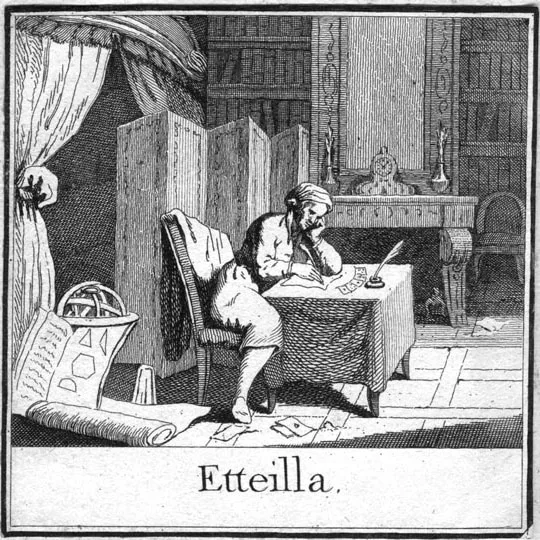
Cartomancy divination by using playing cards that began in the Renaissance was undiscovered until 1785. In the late 1890s, several London-based occultists created the Hermetic Order of the Golden Dawn. It was one of the groups responsible for most of the contemporary magic revival. The Rider-Waite deck remains the most used Tarot variant for novice players and professional card readers.
Over the next hundred years, many mystics from mystery schools continued to expand the role of the Tarot to suit their needs. In the late 1890s, London-based occultists formed the Hermetic Order of the Golden Dawn; this order was one of the groups responsible for the modern magical revival. Two of the group’s founders, husband and wife MacGregor and Moina Mathers, wrote a manual (Templarkey have a PDF copy) that detailed the Tarot’s symbolic power, entitled Book T.
There are literally thousands of books on the subject, including writers on the occult, such as G.H. Frater Sacramentum Regis (A.E. Waite). He gives us his study, THE TAROT AND THE ROSY CROSS (Templarkey have a pdf copy, amongst many other pdf and books we have for The Templarkey School of Tarot). We recommend Kris Hadar as an expert (his books are available on Amazon.
Ancient Egypt & early Decks
In 1943, the occultists Aleister Crowley and Lady Frieda Harris published their interpretation of the Thoth deck, named after the Egyptian god of the alphabet and incorporated specific astrological symbols. For Lady Frieda Harris, see ‘Mercury is in a Very Ape-Like Mood’ Frieda Harris’s Perception of Thelema by the author Deja Whitehouse.
List of oldest Tarot Decks
1. Visconti-Sforza Tarot 1425.
2. Visconti Tarot 1428-1447. The 69 cards left of this deck include the three Theological Virtues: Faith, Hope, and Charity.
3. The so-called Charles VI Tarot, late 14th century.
4. The Sola Busca Tarot, c. 1490.
5. The Tarot de Marseille, c. 1500.
6. The Etteilla Tarot, 1789.
7. The Della Rocca-Gumppenberg Tarot, 1835.
8. The Rider-Waite Tarot, 1909.
9. The Thoth Tarot, 1942.
In 1951 Britain, The Witchcraft Act was repealed, allowing Tarot decks to be printed and sold freely.
10. In 1968, The New Tarot for the Aquarian Age by John Starr Cooke and Rosalind Sharpe was channelled via their Ouija board. This deck was the first “New Age” post-modern deck.
The origins of Tarot Decks: A comprehensive explanation of where Tarot Cards originate, ancient Egypt and Tarot Card meanings
A theory of origin and history of the Tarot card is a belief that numerous intellectuals in later 18th century Europe believed that a particular link existed between Egyptian Mysticism and Tarot card values.
They believed ancient Egyptian writers and traditions had all those secrets yet to come in the same way. The images in Tarot cards represented the symbolism of these secrets and rendered the truth more easily understood.
In Issue 2 [January 2022] of the Templarkey magazine, important mysteries on Tarot will be revealed by the Team. In forthcoming Magazines, The Templarkey School of Tarot will explain a little-known etymology of the word Tarot and explain alternate origins that juxtapose the Dionysian mysteries and Egyptian origins many Tarot scholars propose.
There will be revealing future articles within the Templarkey magazines on Jean-Baptiste Alliette (Etteilla) and “La Clef des Grands Mystères / Suivant Hénoch, Abraham, Hermès Trismégiste et Salomon” (The Key to the Great Mysteries) by Eliphas Levi regarding the Tarot.
